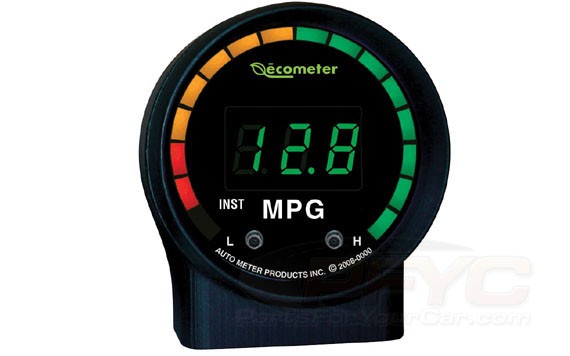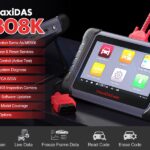Are you looking to get the most miles out of every gallon? In today’s economy, understanding and optimizing your vehicle’s fuel consumption is more important than ever. Devices like the auto meter OBD2 ecometer, also known as an eco gauge or MPG gauge, can be valuable tools in achieving better fuel economy. After several tank fill-ups and real-world testing, here’s a detailed look at the functionality and effectiveness of an ecometer for monitoring your car’s fuel efficiency.
 ecometer
ecometer
Decoding the Ecometer: Modes and Functionality
This particular ecometer unit offers four primary operating modes designed to give you insights into your vehicle’s performance: Instantaneous MPG (MPG-inst), Average MPG (MPG-avg), Miles Per Hour (MPH), and Revolutions Per Minute (RPM). While the ecometer provides real-time data across these modes, the MPG-avg mode stands out as the most consistently useful for drivers focused on fuel economy. The instantaneous MPG, MPH, and RPM readings tend to fluctuate rapidly, making it challenging to derive practical, steady-state information from them at a glance.
Calibration: Fine-Tuning Your Fuel Consumption Readings
A crucial aspect of accurately using an OBD2 fuel consumption meter is calibration. This ecometer comes with a single calibration setting labeled “EFF,” initially set to 100. This setting appears to primarily influence the MPG-inst and MPG-avg readings. Although the EFF value is entered and displayed as an integer, it likely represents an efficiency factor as a decimal (e.g., 100 equates to 1.00, or 100% efficiency).
Initial tests using the factory default EFF setting of 100 revealed that the ecometer’s average MPG readings were overestimating fuel efficiency compared to actual tank fill-up calculations. The formula below illustrates the observed discrepancy:
- Tank #1: 0.893 = (1.00) * (34.1mpg / 38.2MPG)
- Tank #2: 0.861 = (1.00) * (32.1mpg / 37.3MPG)
- Tank #3: 0.935 = (1.00) * (34.5mpg / 36.9MPG)
To rectify this overestimation and achieve more accurate readings, the EFF setting was adjusted downwards to 90. Subsequent testing showed a closer alignment between the ecometer’s MPG-avg display and the MPG calculated at each tank fill-up:
- Tank #4: 0.887 = (0.90) * (33.8mpg / 34.3MPG)
These results suggest that for this specific Pontiac (Toyota) 1.8L (2ZR-FE) engine, an EFF setting in the range of 0.88 to 0.90 provides a more reliable fuel consumption gauge. Further tank fill-ups will help to solidify this calibration range.
The Calibration Formula Explained
For those looking to calibrate their own ecometer, the basic formula, though not explicitly provided in the user manual, is derived as follows:
EFF(new) / EFF(old) = mpg(tank) / MPG(meter)
This formula can be rearranged to solve for the new, more accurate EFF setting:
EFF(new) = EFF(old) * [ mpg(tank) / MPG(meter) ]
Where:
- EFF(new) = The new calibration number you are calculating.
- EFF(old) = The current EFF setting in your ecometer during the test period.
- mpg(tank) = Miles per gallon calculated from a tank fill-up (miles driven / gallons filled).
- MPG(meter) = The average MPG value displayed by the ecometer (MPG-avg).
Limitations and Considerations
It’s important to note that this ecometer utilizes a single EFF calibration setting, which applies to MPG readings. There are no independent adjustments for distance (MPH) or fuel volume (GALLONS) measurements. This simplified approach, while user-friendly, lacks the flexibility to compensate for vehicle modifications that affect distance or fuel measurements, such as changes in tire or wheel sizes.
Additionally, both RPM and MPH readings are displayed as 3-digit values. RPM is shown in thousands (e.g., 1.42 represents 1420 RPM), offering accuracy to the tens of RPM. MPH is displayed with one decimal place (e.g., 64.9 mph). However, both readings exhibit minor fluctuations, typically jumping around by a few digits in the last decimal place, which can make precise real-time interpretation slightly challenging.
Conclusion: Is an Ecometer Right for You?
Despite some limitations in display precision and calibration simplicity, an auto meter OBD2 ecometer can be a useful tool for drivers keen on monitoring and improving their fuel economy. By focusing on the average MPG reading and properly calibrating the device to your specific vehicle, you can gain valuable insights into your driving habits and their impact on fuel consumption. This understanding is the first step towards making informed decisions to enhance your vehicle’s fuel efficiency and save money at the pump.
